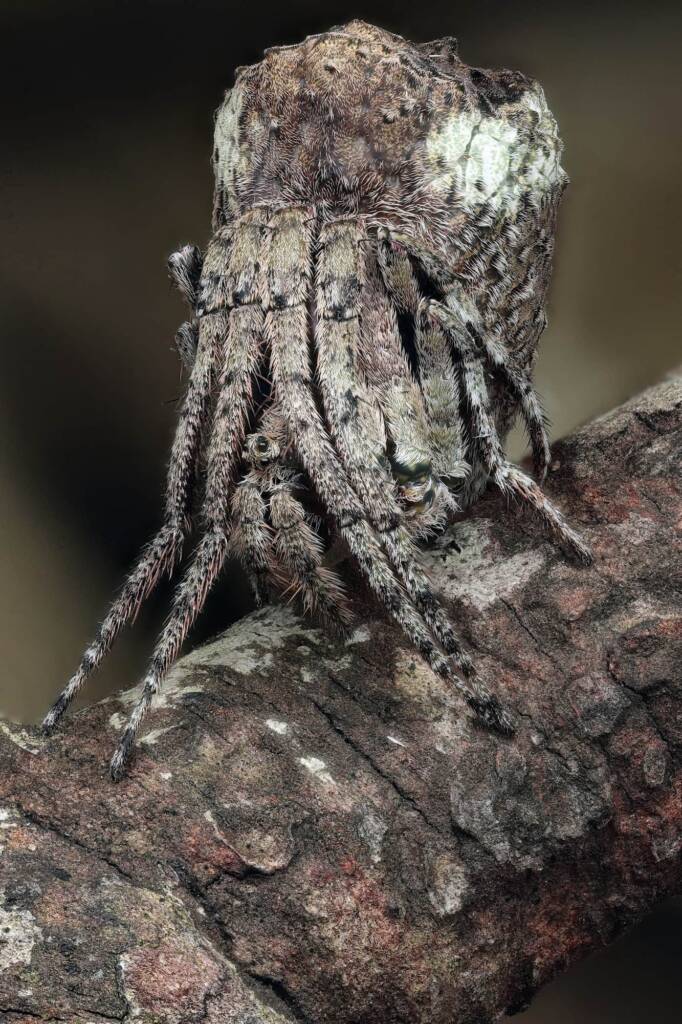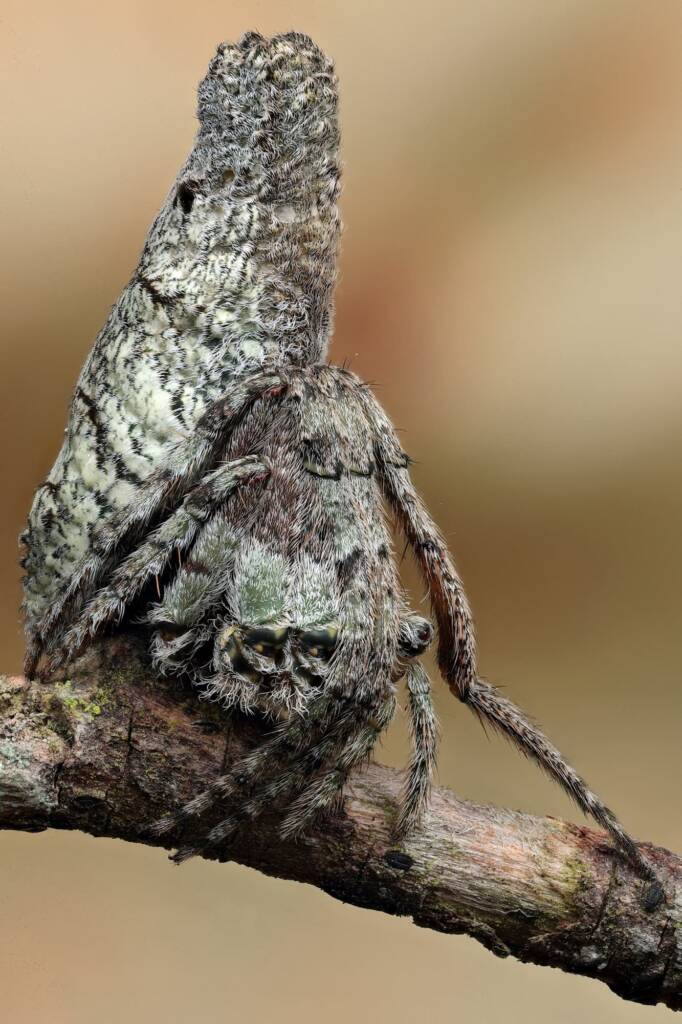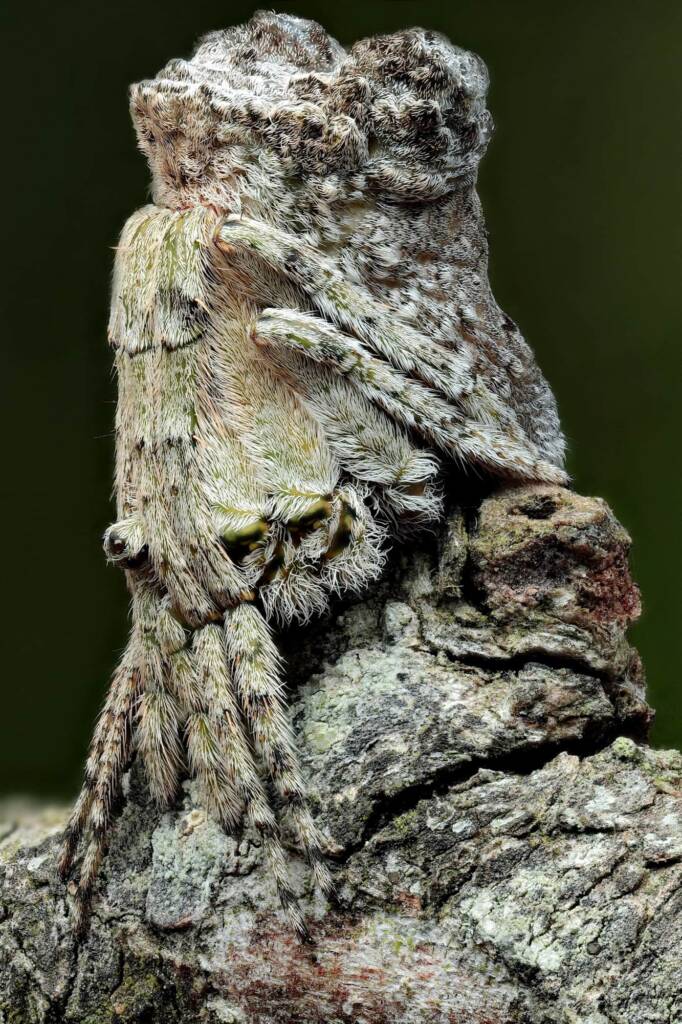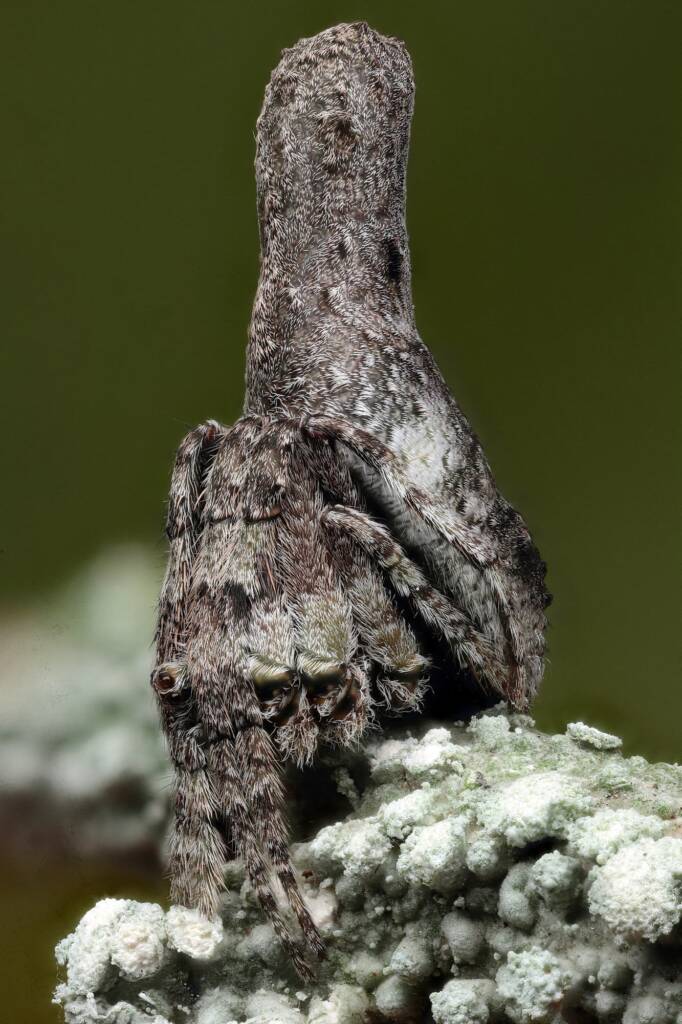The genus Poltys in the Orbweavers family Araneidae is a distinctive group of spiders that uses camouflage, which allows them to blend in against the leaves and twigs of shrubs and trees, where they are usually found. Most of the known Australian species are active at night, during which time they build an orb web to capture their prey. The web is then re-ingested around dawn.

Poltys C.L. Koch is a rather distinctive araneid genus that can be recognized by a combination of widely separated lateral eyes and a pear-shaped carapace, where the “stalk” of the pear is an eye tubercle.
Source: A revision of the genus Poltys in Australasia (Araneae: Araneidae), Australian Museum3

The Poltys sp spiders give the impression of a stubby, rough, broken branch. The shape varies between species and can vary even among individuals within a species.
The colouration can also vary from shades of brown, grey, orange, cream to creamy-yellow. Some will have black colouration around the eyes, others will be dark, with pale hairs. Some Poltys sp display colours on the abdomen and legs similar to the lichen and algae found growing on the bark of some shrubs and trees.
The variation found in most Australian species of the genus Poltys, especially in the abdominal shape and/or colouration, has led to inconsistencies in the taxonomic descriptions and hence confusion in the species identification. Even with a single species there is thought to be two or three sister species within each specie.

Many members in the genus Poltys sp are described as “cryptic”. In biology, a “species complex” is a group of closely related organisms that are so similar in appearance and other features that the differences between them are often unclear. In such cases, the species within the group complex may be able to procreate with each other. They are often referred to as “cryptic species”, in which two or more species are found under the one species name.
This is not to be confused with “cryptic speciation”, a biological process that results in a group of species (which, by definition, cannot interbreed) that contain individuals that are morpholigically identical to each other, but belong to different species.6

In their camouflage motionless state, some Poltys species drawn their legs up tightly around the prosoma, with just the median eyes (which are situated on the anterior of the eye tubercle) protruding between the legs. The prosoma or cephalothorax (refers to the combined head and thorax) of the spider.
A fascinating pose, that resembles a dead twig, a gall or a broken piece of wood.3
- Scientific classification
- Kingdom: Animalia
- Phylum: Arthropoda
- Subphylum: Chelicerata
- Class: Arachnida
- Order: Araneae
- Suborder: Araneomorphae
- Infraorder: Entelegynae
- Superfamily: Araneoidea
- Family: Araneidae
- Genus: Poltys
- Species:
- Poltys acuminatus
- Poltys apiculatus
- Poltys baculiger
- Poltys bhabanii
- Poltys bhavnagarensis
- Poltys caelatus
- Poltys columnaris
- Poltys corticosus
- Poltys dubius
- Poltys elevatus
- Poltys ellipticus
- Poltys fornicatus
- Poltys frenchi — Australia (QLD), New Guinea, Indonesia
- Poltys furcifer
- Poltys godrejii
- Poltys grayi — Australia (Lord Howe Is)
- Poltys hainanensis
- Poltys horridus
- Poltys idae
- Poltys illepidus — Australia (mainland, Lord Howe Is, Norfolk Is), Thailand
- Poltys jujorum — Australia (QLD)
- Poltys kochi
- Poltys laciniosus — Australia
- Poltys longitergus
- Poltys milledgei — Australia (WA, NT), Indonesia
- Poltys monstrosus
- Poltys mouhoti
- Poltys nagpurensis
- Poltys nigrinus
- Poltys noblei — Australia ( QLD, NSW, VIC)
- Poltys pannuceus
- Poltys pogonias
- Poltys pygmaeus
- Poltys raphanus
- Poltys rehmanii
- Poltys reuteri
- Poltys squarrosus
- Poltys stygius — Australia (QLD), Myanmar
- Poltys timmeh
- Poltys turriger
- Poltys turritus
- Poltys unguifer
- Poltys vesicularis
Footnote & References
- Photographs (Project Maratus) © Michael Doe
- Michael Doe on Flickr – spiderphotography21 and michael doe (Project Maratus)
- A revision of the genus Poltys in Australasia (Araneae: Araneidae), by Helen M. Smith, Australian Museum, https://media.australian.museum/media/Uploads/Journals/18033/1465_complete.pdf
- Twig Spiders (Genus Poltys), iNaturalistAU, https://inaturalist.ala.org.au/taxa/209672-Poltys
- Poltys (spider), Wikipedia, https://en.wikipedia.org/wiki/Poltys_(spider)
- Cryptic speciation, Amateur Entomologists’ Society, https://www.amentsoc.org/insects/glossary/terms/cryptic-speciation/
SpidersIndex of Spider Images Spiders in Australia Araneidae — Orb Weavers Arkys Australian Huntsman Spider Barking Spider Black House Spider Carepalxis sp Celaenia sp Crab Spiders Deinopidae — Net-casting Spiders Dolomedes sp Dolophones sp Flower Spiders Hackled Orbweavers (Uloboridae) Jewel Spider Jumping Spider Long Jawed Spider (Tetragnatha sp) Lynx Spider (Oxyopes) Mangrovia albida Maratus volans Missulena occatoria (Red-headed Mouse Spider) Miturgidae Nicodamidae (Red and Black Spider) Ogre-faced Net-casting Spider Poltys sp (Twig Spider) Redback Spider Scorpion-tailed Spider (Arachnura higginsi) Thomisidae Tiger Spider (Trichonephila plumipes) White-spotted Swift Spider (Nyssus albopunctatus) Wolf Spider











